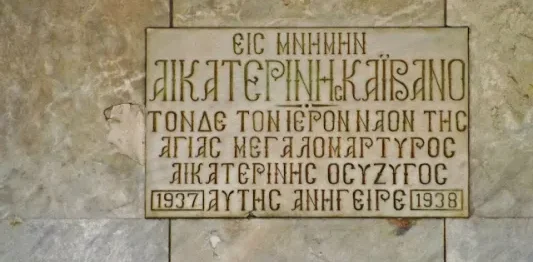By Amalia Theocharidou,
St. Aikaterini is a beautiful church, situated on the coastal road of Piraeus, Greece. Its beautiful architecture and the charming green surrounding the temple despite its urban environment, makes it –in my opinion –, one of the most beautiful churches in the city. But, despite the gorgeous looks, a dark history lays behind the constructions, which was only recently revealed.
Back in the 20th century, an Italian civil engineer, named Vincenzo Caivano, who was currently living in Constantinople, met through matchmaking – a common practice of the era – Aikaterini Lempesi, a beautiful girl who lived in Piraeus at the time. The couple got married in 1906 and Caivano was all over the moon, declaring his love for Aikaterini. But fate had other plans for the newly wedded, as almost thirty years later, Aikaterini died. The devastated husband then asked for mayoral permission to build a church of St. Aikaterini in the loving memory of his wife at Alexandra’s Square, stating that she was a fateful believer. It was a rocky start, nevertheless, as the mayor controverted, declaring that it was much of a precious spot to be given to that case. Caivano did not quit, though, and constantly traveled from Constantinople to Piraeus, accompanied by a group of engineers who would design the church.
The local Council decided to grand Caivano another spot so that he could honor his wife’s Christian memory, near the area of Tourkolimano, but he kept denying and persisting to the certain square to the point of obsession. The Greek Council appeared stunned by his persistence and started wondering if something else was lurking behind his strong will, given the fact that a Catholic was ready to start a harsh judicial battle with the mayor and spend a fortune, in order to build a church, for a religion he wasn’t even a believer of. The city’s hustle and bustle sharpened when the (previously) excited inhabitants of Piraeus found out that the church would also serve as a mausoleum for the late Aikaterini. Given the fact, though, that she was a known provider for the local society, with a big list of charity work, Piraeus soon accepted it.
In 1936, the construction began, under the auspices of Caivano, whose spousal love had created an aura of respect. Specifically, he’d designed a crypt and a chapel of St. Vincent, in which the stuffed body of his wife would be kept and transferred in 1938 from Constantinople. The care with which the body was treated was outstanding, as the Italian engineer specifically asked for such a delicate work, that the features of his wife wouldn’t be altered at all and preserved for an eternity. Testimonies of the residents claim that Caivano would stay locked in the church up to three hours, wearing black and crying over the loss of his wife, as well as that he’d eat after making the servants prepare dinner for two people. Some also claim that they heard Caivano talk to his wife’s empty seat.

As the war between the Greeks and the Italians started, the British forces who allied with Greece noticed weird signals being sent from St. Aikaterini, and while Vincenzo was out of the city for work, they searched the crypt and the stuffed body. The result was astonishing. Under the head, for which Caivano had specifically asked for special treatment, a transmitter was spotted, sending signals to the Italian army. After the surprising finding, the counter-espionage Greek forces conducted an operation, which resulted to the arrest of Vincenzo, under the crime of espionage.
Up to this day, St. Aikaterini, as well as the chapel of St. Vincent, is open to public visits, as the church is in normal use. The older believers still cherish the story and spread it forward, for the next generation to come across it.
Reference
- Το μυστικό της εκκλησίας στον Πειραιά που έκρυβε έναν παράνομο πομπό μέσα στο μαυσωλείο. Πως τον εντόπισε η βρετανική αντικατασκοπεία κάτω από το λείψανο της γυναίκας του δωρητή που ήταν κατάσκοπος της Ιταλίας, mixanitouxronou.gr. Available here




